To grow juicy vegetables in sunny conditions, you'll want to focus on smart watering and soil management. Water deeply in the early morning, aiming for 6-12 inches of soil penetration. Set up a drip irrigation system with timers for consistent moisture. Apply 2-4 inches of organic mulch to retain water and keep roots cool. Plant companions like squash to provide natural shade, and space your vegetables properly to prevent competition. Use shade cloth during intense heat periods, and harvest in the cool morning hours. Maintain proper soil moisture with compost additions. These proven techniques are just the beginning of your journey to garden-fresh, succulent vegetables.
Smart Water Timing Techniques
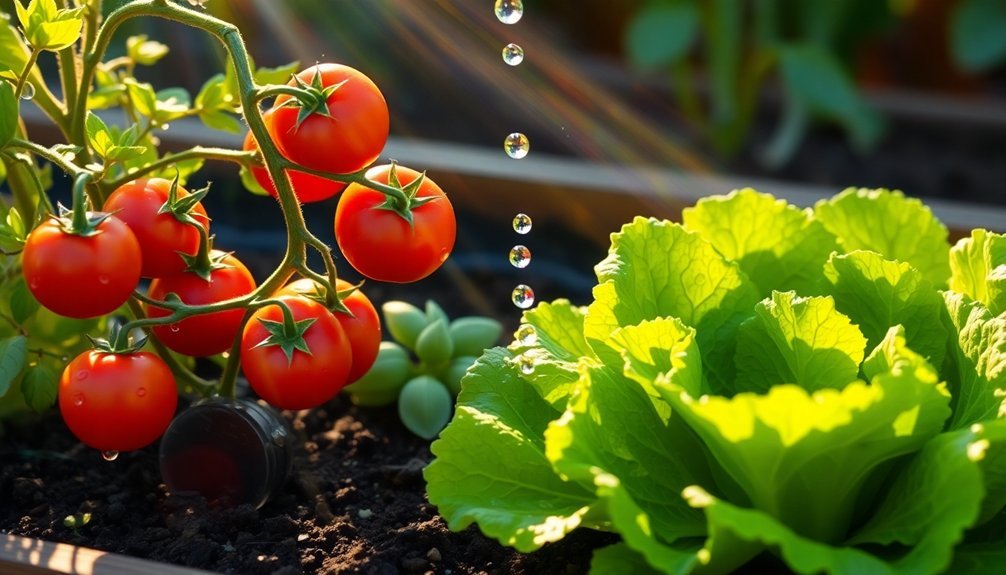
When it comes to growing juicy vegetables, proper watering timing can make or break your garden's success.
You'll want to water during the morning or mid-day when the sun reaches its peak, as this reduces water loss through evaporation. Early morning is particularly ideal since it gives your plants time to absorb water before the heat intensifies. Using soaker hoses will deliver water directly to plant roots while minimizing waste.
Don't water in the evening, as overnight moisture can lead to fungal diseases that harm your vegetables.
If you're in a hot or arid climate, you'll need to adjust your watering frequency accordingly.
To make timing easier, install a battery-operated timer that'll maintain consistent watering schedules even when you're away. This automation guarantees your vegetables receive water at prime times, supporting healthy growth and juicy results.
Deep Root Watering Methods
Deep root watering stands as one of the most effective methods for producing juicy, healthy vegetables in your garden.
You'll want to moisten the soil to depths of 6-12 inches, ensuring water reaches your plants' entire root system. Instead of daily shallow watering, focus on deep watering two to three times weekly.
To implement this method effectively, you can use several tools: drip irrigation systems, soaker hoses, or DIY deep root tubes.
Place these devices at the base of your plants, allowing water to slowly penetrate the soil. You'll know you're watering deeply enough when a metal rod easily slides 6-12 inches into the moistened soil.
During hot, dry spells, you might need to increase watering frequency, but don't sacrifice depth – it's what encourages strong root development and ultimately produces those juicy vegetables you're aiming for. This practice is especially beneficial as it promotes enhanced drought tolerance in your plants.
Natural Mulching Secrets
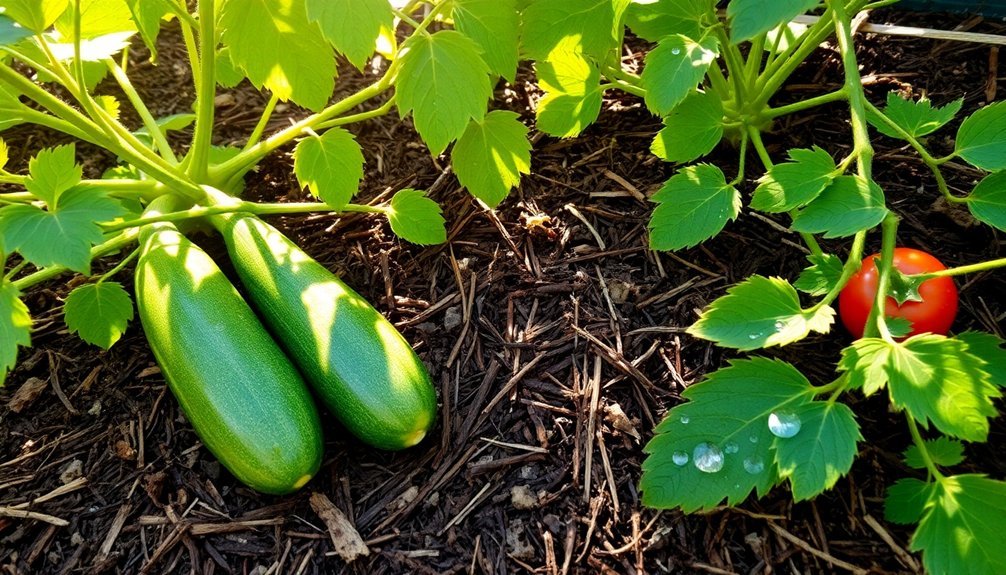
Natural mulching serves as a cornerstone of successful vegetable gardening, offering multiple benefits that directly contribute to producing juicier vegetables.
You'll want to layer your mulch 2-4 inches thick, keeping it an inch away from plant stems to prevent rot.
For ideal results, combine different types of mulch. Start with grass clippings, which are rich in nitrogen, then add shredded leaves for moisture retention. Mixing grass clippings with straw provides maximum nutrient benefits for your vegetables.
Pine needles work exceptionally well for strawberries, lifting fruit off the soil. You can also implement the chop-and-drop method with spent crops, returning essential nutrients to the soil.
Apply mulch right after planting but before your first watering. For warm-season crops, wait until the soil has warmed up.
You'll notice reduced weeding needs, better water retention, and protection against temperature extremes.
Companion Plant Moisture Support
Building on effective mulching practices, strategic companion planting can greatly boost moisture retention in your vegetable garden.
Plant squash and other broad-leafed companions to shade the soil, reducing evaporation and suppressing weeds. You'll get excellent results by growing corn with beans and squash in the traditional Three Sisters method, where squash leaves act as living mulch.
Make the most of vertical space by training cucumbers on trellises to shade moisture-loving lettuces below.
Group plants with similar water needs together, and you'll optimize your watering routine while maintaining consistent soil moisture.
Don't forget to include pest-deterring companions like marigolds, basil, and nasturtiums – they'll protect your vegetables from moisture-robbing pest damage while improving overall soil health and water retention.
Solar Shade Management
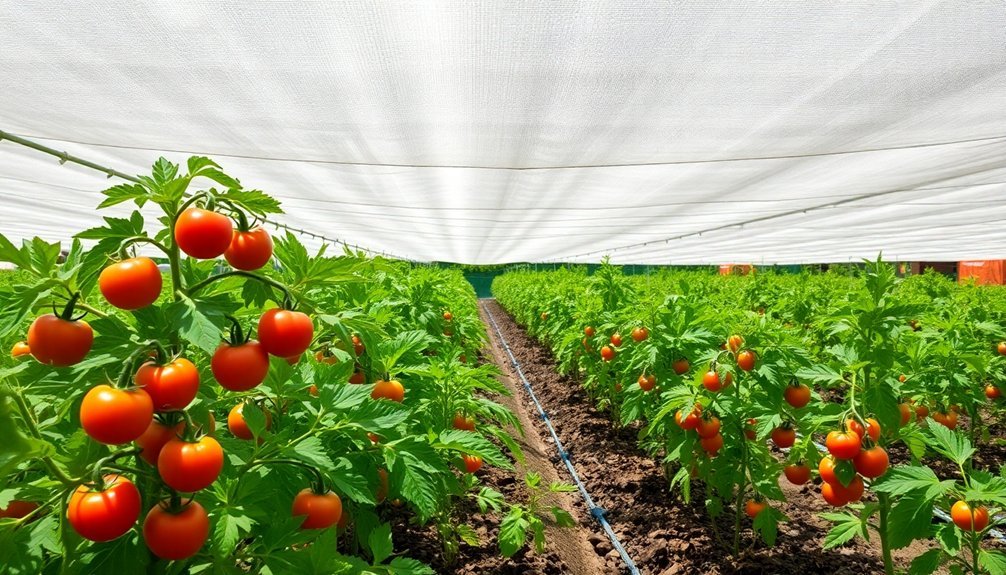
Carefully managing sunlight exposure is essential for growing juicy, flavorful vegetables.
You'll need to understand different shade levels and match them to your crops' specific needs to maximize moisture retention and prevent stress.
For the juiciest vegetables, follow these key shade management strategies:
- Position leafy greens like lettuce and spinach in dappled shade, where they'll get filtered light through tree canopies while retaining moisture.
- Place root vegetables in areas with 5-6 hours of morning sun, protecting them from harsh afternoon heat.
- Give fruiting plants like tomatoes and peppers 7-8 hours of direct sunlight, but provide afternoon shade in hot climates.
- Use companion plants with taller growth habits to create natural shade zones for moisture-loving crops below.
This balanced approach to solar exposure will help maintain ideal moisture levels in your vegetables.
Soil Moisture Retention Tricks
Whether you're growing tomatoes or tender greens, maintaining consistent soil moisture is essential for producing juicy vegetables.
You'll get remarkable results by incorporating organic matter like compost or worm castings into your soil, as they can hold over 20 times their weight in water. Adding just 5% more organic matter quadruples your soil's water-holding capacity.
Create a protective barrier by applying 1-3 inches of organic mulch, such as straw or several layers of newspaper. This simple step can cut your plants' water needs by half while keeping soil cool and moist.
You'll also want to understand your soil type – clay retains water longer than sand – and adjust your watering schedule accordingly. Use moisture monitoring tools to make informed decisions, and don't forget to remove water-stealing weeds regularly.
Morning Harvest Best Practices
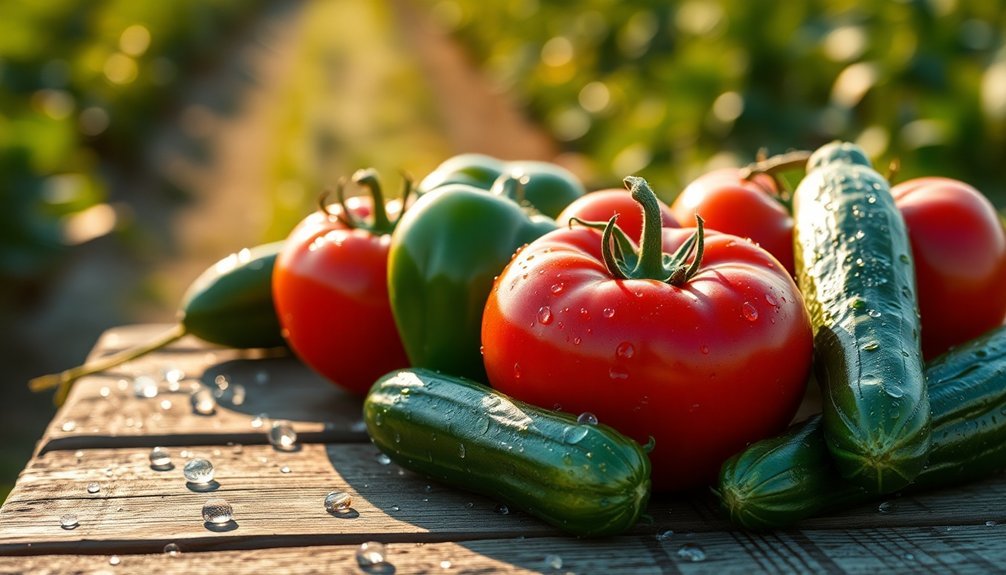
Let's explore your morning harvest timing to catch vegetables at their peak moisture levels, while the early dew lingers but hasn't fully dried.
You'll find the sweet spot for picking when temperatures hover between 45-65°F, just as the sun begins to rise but before it directly hits your garden.
When cutting, hold the stem firmly near the base and use sharp, clean shears at a 45-degree angle to maximize the plant's ability to heal and prevent moisture loss.
Early Dew Collection Tips
The perfect morning harvest starts with understanding the delicate balance between dew and timing. You'll want to wait until the morning dew has dried from your vegetables, but before the sun's heat intensifies. This sweet spot guarantees your produce stays crisp and develops peak flavor while preventing moisture-related issues.
Here's what you'll need to watch for when managing dew during harvest:
- Check that leaves and fruits are completely dry to prevent fungal growth
- Avoid harvesting right after rainfall to maintain longer storage life
- Use clean, sharp tools instead of pulling to prevent plant damage
- Start with outer leaves on greens, working your way inward
Best Temperature For Picking
When should you head out to harvest your vegetables? The early morning hours provide ideal conditions when temperatures range between 70-85°F. You'll find your produce at its sweetest and juiciest during this time, before the day's heat sets in.
For most vegetables, especially leafy greens and broccoli, early morning harvesting prevents wilting and bitter flavors.
However, there's one notable exception: tomatoes achieve their peak sugar concentration during midday. If you're picking heat-sensitive crops like lettuce or beets, don't wait until afternoon when temperatures climb above 90°F, as this can affect their texture and taste.
Remember that different vegetables have varying temperature tolerances. While squash and peppers can handle higher temperatures, you'll get the best results from most garden vegetables by harvesting them in the cool morning air.
Proper Cutting Techniques
To guarantee your vegetables retain maximum freshness and flavor, proper cutting techniques during morning harvests make all the difference.
You'll need clean, sharp tools to minimize damage and prevent disease from entering the cuts. This precision approach helps your vegetables stay crisp and juicy while protecting the plant for future harvests.
When cutting your vegetables in the early morning, follow these essential steps:
- Choose sharp scissors or pruners that you've thoroughly cleaned
- Make quick, decisive cuts just above growth points for leafy greens
- Cut squash and cucumbers at an angle with clean pruners
- Snap peas and beans with a gentle twist rather than cutting
Strategic Plant Spacing
Proper spacing between plants serves as a cornerstone for growing juicy, healthy vegetables in your garden.
You'll need to adjust spacing based on your vegetable type. Root vegetables like carrots and beets need minimal space, typically 1-4 inches between plants, while leafy greens vary greatly – head lettuce requires 12 inches, but leaf lettuce needs only 1-3 inches.
For maximum juiciness, give brassicas plenty of room to develop. Plant your broccoli and cauliflower 18-24 inches apart, with rows spaced at 24-36 inches.
Vining vegetables demand the most space – especially pumpkins, which need 5-6 feet between plants and 10-15 feet between rows. If you're growing cucumbers, consider trellising to save space, reducing row spacing from 60 inches to just 30 inches.
Drip Irrigation Excellence
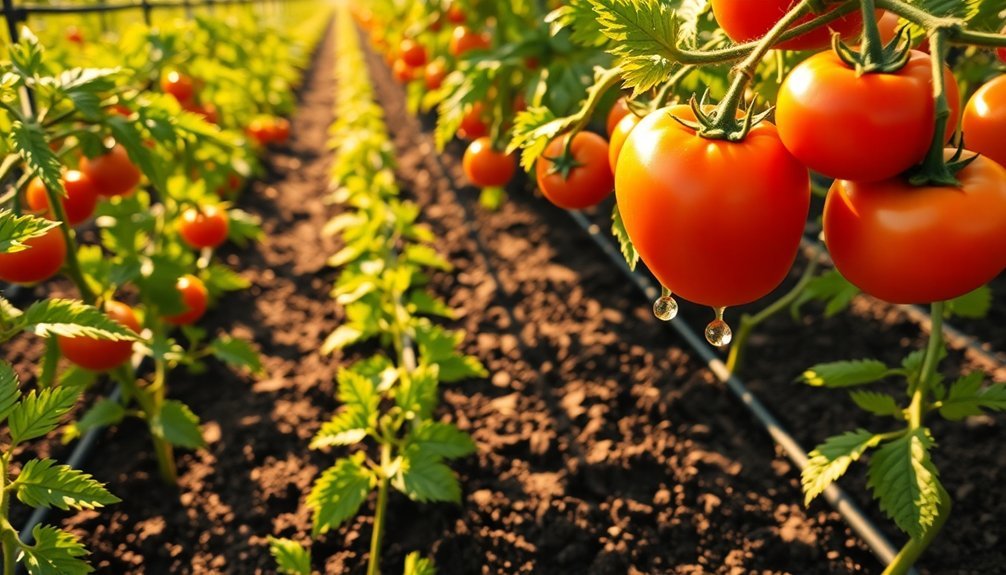
Your drip irrigation system needs a water source, filter, pressure regulator, tubing, and emitters to deliver precise moisture to your vegetables' root zones.
Set up automatic timers to water plants in the early morning hours, typically between 2-3 times per week depending on your climate and soil conditions.
You'll maximize water efficiency and prevent disease by maintaining consistent soil moisture at 1-2 inches below the surface, rather than flooding the soil or letting it dry completely.
Essential Drip System Components
When setting up a reliable drip irrigation system, you'll need several essential components working together to deliver water efficiently to your vegetables. The heart of your system starts with a clean water source and proper filtration to prevent clogging. You'll want to make certain your water's free from high iron content and debris that can damage the system.
- Distribution components: PVC pipes or flexible mainline tubing (typically ½ inch) to carry water throughout your garden.
- Drip elements: Either drip tape with pre-cut slits or drip tubes with inserted emitters.
- Control features: Pressure regulators, programmable controllers, and shut-off valves to manage water flow.
- Safety items: Backflow preventers (if using municipal water), filter screens, and repair supplies like goof plugs.
Remember to include chemical injectors if you'll be fertilizing through your system.
Ideal Watering Schedule Setup
Setting up a smart watering schedule takes the guesswork out of drip irrigation once you've installed your system components.
You'll need to apply about one inch of water weekly, which translates to 0.623 gallons per square foot.
For clay soils, schedule 5-6 hour sessions twice weekly. If you're in an inland area, you'll likely need more frequent watering than coastal regions.
Monitor your vegetables' response and adjust accordingly – wilting plants signal insufficient water, while vigorous growth indicates you're on track.
Don't forget to modify your schedule seasonally. You'll need longer, more frequent sessions during hot summer months and reduced watering in winter.
Use a moisture meter to fine-tune your timing, and maintain a log to track what works best for your garden's specific conditions.
Maintain Moisture Without Overwatering
Three key principles drive successful drip irrigation: direct root-zone delivery, slow absorption rates, and strategic moisture management.
Your vegetables will thrive when you implement these proven methods that deliver 90% water efficiency compared to sprinklers' 65-75%.
To maximize your drip irrigation system's effectiveness:
- Install flexible polyethylene tubing with emitters spaced 12 inches apart for vegetables.
- Layer mulch around your drip lines to trap moisture and reduce surface evaporation.
- Set your system to deliver 110-120% of crop water needs to guarantee proper coverage.
- Clean emitters regularly to prevent clogging and maintain consistent flow.
You'll notice healthier plants with this approach, as it prevents disease by keeping leaves and stems dry while delivering water directly where it's needed – the root zone.
Heat Protection Measures
To protect vegetables from intense heat damage, you'll need a combination of strategic timing and practical barriers.
Water your garden early in the morning before temperatures rise, as moist soil stays cooler throughout the day. Avoid watering during peak heat when evaporation is highest.
Apply a generous layer of light-colored mulch, such as straw or dry grass clippings, to reflect sunlight and retain moisture.
Don't use black plastic, which can overheat the soil.
Install shade cloth on stakes or hoops, using 30% coverage for most vegetables and up to 70% for heat-sensitive crops like lettuce.
Choose heat-tolerant varieties when possible, such as Annihilator snap beans and Red Bounty tomatoes.
Maintain good air circulation by pruning dense foliage, and add windbreaks to shield young plants from hot summer breezes.
Frequently Asked Questions
Can Vegetables Become Too Juicy if Overwatered During High Temperatures?
Yes, you'll find that overwatering during high temps can make vegetables waterlogged and less flavorful. Your plants' roots will suffocate, leading to mushy produce and reduced nutrient content in the vegetables.
Why Do Some Vegetables Split Open Even With Consistent Watering?
Even with consistent watering, your vegetables can split due to genetics, rapid growth periods, calcium deficiencies, or heavy rainfall. You'll notice this especially in tomatoes and melons, as their insides grow faster than outer skins.
Does Pruning Affect the Juiciness of Vegetables Like Tomatoes?
Yes, pruning affects your tomatoes' juiciness. When you prune correctly, you'll direct more energy to fruit production rather than foliage, resulting in juicier fruits. However, over-pruning can stress plants and reduce quality.
How Does Soil Ph Impact the Water Content of Vegetables?
You'll get juicier vegetables when soil pH is between 5.5-7.0, as it optimizes water uptake through healthy roots. When pH's too high or low, roots can't absorb water efficiently, making vegetables less succulent.
Will Fertilizing During Fruiting Stage Make Vegetables More or Less Juicy?
Proper fertilizing during fruiting will make your vegetables juicier, but you'll need to maintain balance. Too much fertilizer can reduce quality, while the right amount supports water uptake and fruit development.
In Summary
You've now got the essential tools to grow remarkably juicy vegetables even in full sun. By combining smart watering techniques, mulching strategies, and proper spacing, you'll create an environment where your plants thrive. Remember to protect them from intense heat, time your harvests wisely, and let companion plants work their magic. Put these methods into practice, and you'll enjoy the most succulent homegrown vegetables yet.


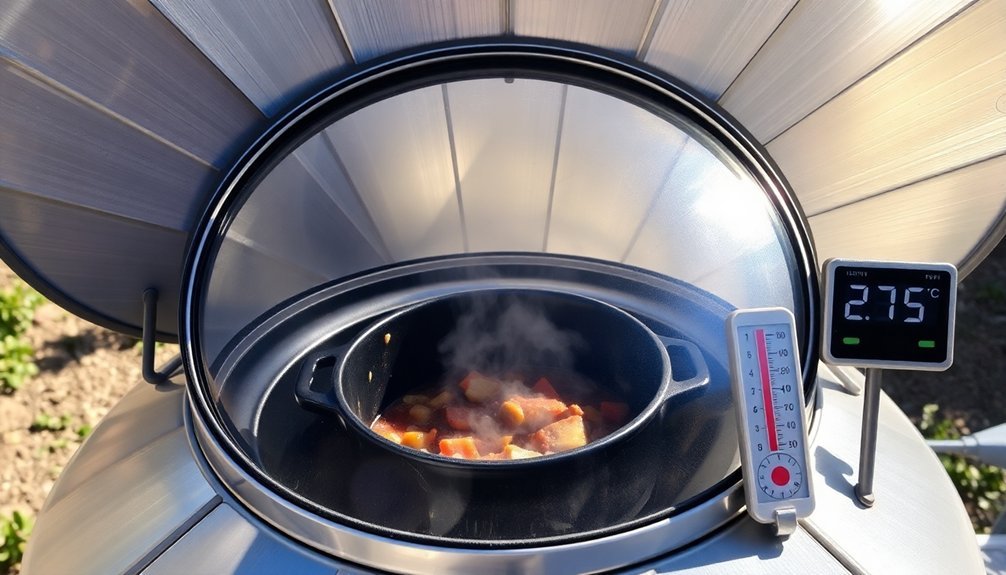


Leave a Reply